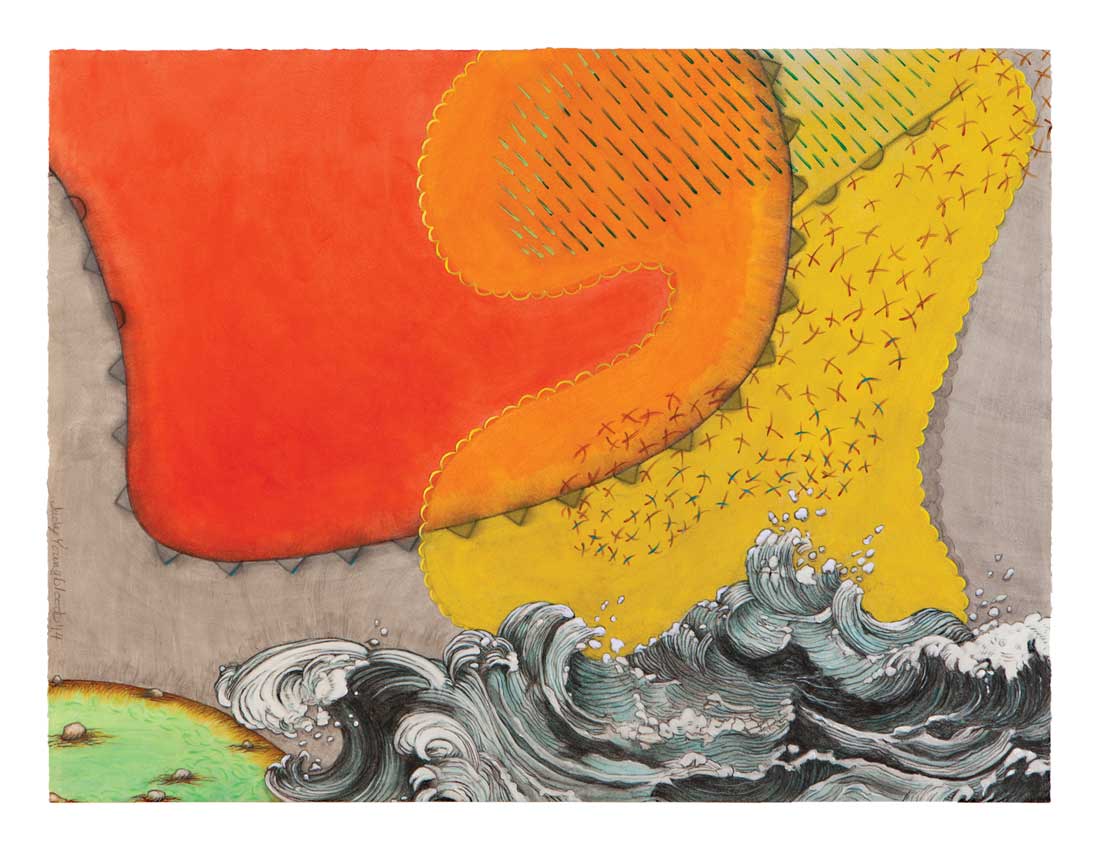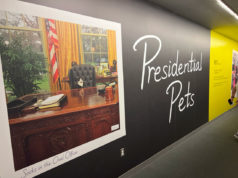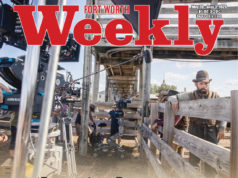There’s an inspired goofiness and an inviting tactility to many of the paintings, prints, and mixed-media works in Changing Weather, Judy Youngblood’s current show at William Campbell Contemporary Art. As the title implies, the art is focused almost exclusively on meteorological phenomena –– specifically, rain and hail –– rendered from both a satellite’s and a microscope’s eye. Fat, shiny raindrops fly from spongy, corrugated clouds onto glassy puddles or rock-strewn planetary surfaces, sometimes making epic, up-close splashes and sometimes dissolving before they touch the distant ground. Global weather fronts look like vibrantly colored amoeba and paramecia squirming their way across vast surfaces. Hailstones look like puffy, happy pieces of detached cloud rather than treacherous airborne ice rocks.
Like most artists, Youngblood, a former Fulbright Scholar and University of North Texas professor emeritus who taught for more than two decades in Denton, takes a multilayered approach to her subject matter. She loves the dense colors and textures of chaotic weather, but the phenomena, for her, are symbolic of much more than atmospheric combinations of air and moisture.
“The conflict between the human need for repetition and the longing for change has always interested me,” she said. “Weather is a good visual way to explore that idea. It’s such a violent force in our everyday lives, especially here in Texas. Is the coming rainstorm going to bring the water that you need for the wheat kernels to grow, or will it bring the flood that will destroy your home? And of course, water is a very political issue now [because of the ongoing drought and climate change]. It’s a universal image that encompasses many experiences.”
While Youngblood speaks about chaos and change, the variety of storms represented in Changing Weather are intriguingly comforting, even friendly. Drops of water are the dominant motif. Youngblood deliberately uses the iconic graphic teardrop shape because she doesn’t want to abstract her streaming water into unrecognizable lines. As a result, there is a vague Pop Art feel to the work, though that reference feels incomplete. The artist indeed collects comic strip representations of weather, but her artistic influences are decidedly more obscure and historical than that. She mentions 19th-century wood engravers like Thomas Bewick and Gustave Doré, who created intricately lined, high-contrast prints for publications like Harper’s and The Strand. But while those illustrations could be precise and clinical, there is a louche quality to Youngblood’s cloud and water formulations that’s reminiscent of the swollen decadence of swirls and circles by 19th-century ink illustrator Aubrey Beardsley.
The biggest piece in Changing Weather is a 35-foot rainstorm installation that covers two walls. Previous iterations of it appeared earlier this year in her one-woman shows at the Amarillo Museum of Art and Flatbed Gallery & Press in Austin. The template for all three installations was roughly the same –– clouds at the top, rain in the center, ground at the bottom. Youngblood adjusted the shapes and styles of the composition to fit each venue, but, ultimately, she wanted to achieve the same impression: to have the viewer walk into the room and be immersed in a stylized deluge of plump, organic shapes in constant motion.
While those omnipresent cartoon raindrops don’t leave much room for personal interpretation, more abstract works such as “Late Spring Hail” and “Colliding Fronts” depict globular fields of warm and rich reds, yellows, and blues interacting in some mysterious, crowded chemical process that feels relentless but not threatening. They could be especially sociable colonies of aquatic creatures or tiny biological life forms engaged in a perpetual dance of merging and separating. Youngblood has been delighted at the Rorschach-like response some of these pieces have elicited.
“A man I’ve known for a long time, a biochemical engineer, just bought one of the pieces in the show,” she said. “He was beside himself with joy when he saw it. He said, ‘That looks just like … ,’ and he named something microscopic. I’m trying to relate these images [of weather] to the human body as well, to make them round and three-dimensional. And then people can bring to it what they want to.”
[box_info]
Judy Youngblood: Changing Weather
Thru Oct 11 at William Campbell Contemporary Art, 4935 Byers Ave, FW. Free. 817-737-9566.
[/box_info]












